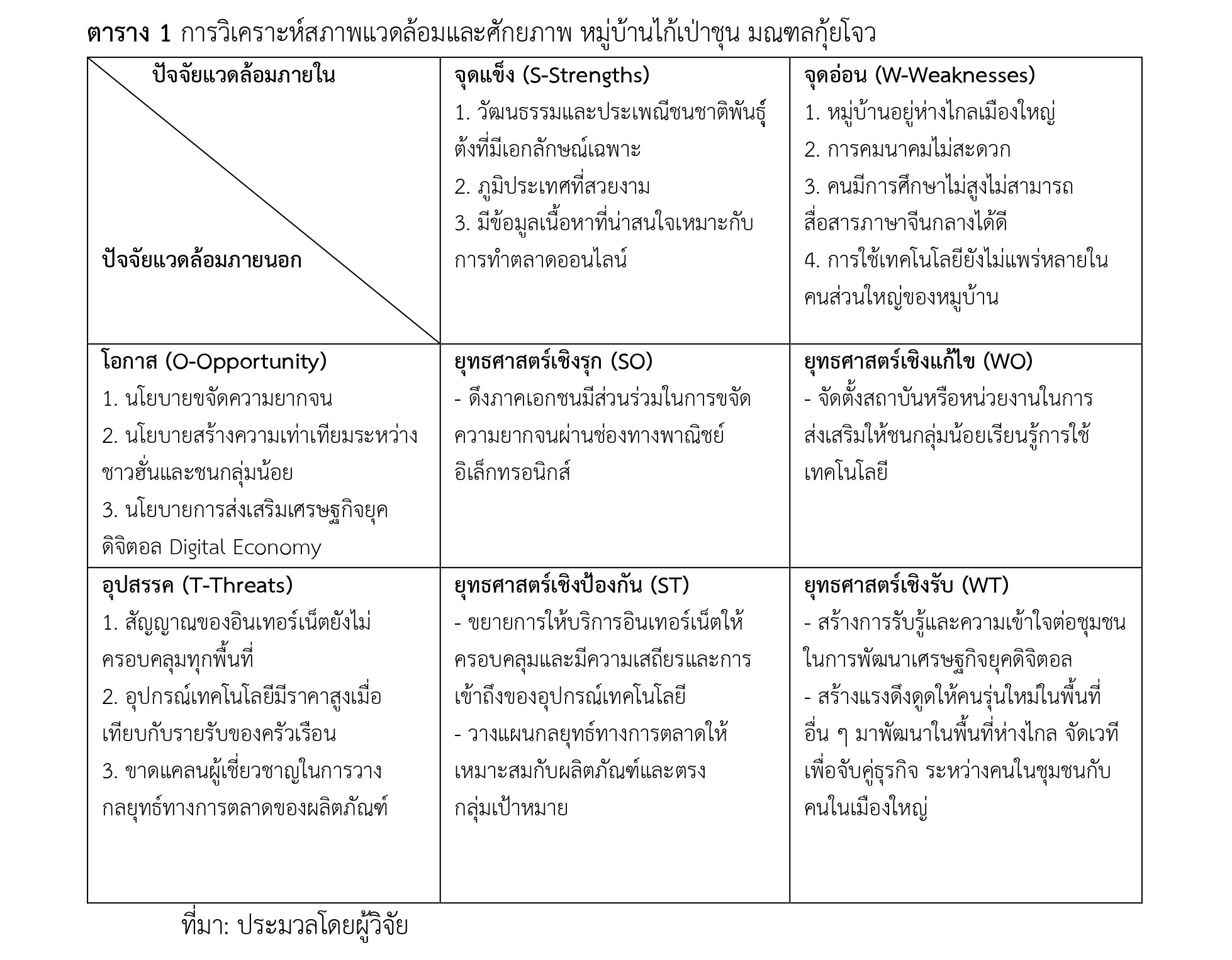The Study of Using Cultural Heritage as an E-commerce Product to Solve Poverty in Ethnic Areas of China: A Case Study of Gaibao Village, Guizhou Province
DOI:
https://doi.org/10.14456/psruhss.2024.15Keywords:
Cultural heritage, Technology, Poverty, ChinaAbstract
This is qualitative research that aims to study the mechanisms and patterns for using the internet to disseminate cultural heritage through electronic commerce channels. This research also explores the opportunities and obstacles to solving poverty issues through the distribution of cultural products through e-commerce. This research employs documentary research combined with conceptual analysis, theory, and other factors relevant to our research. The authors also analyze the factors that affect the effects of policy implementation. Data collection was done through research articles, newspapers, and periodicals on education in China and overseas. Further data analysis was conducted before implementing descriptive analysis in the research report.
The research results reveal that: 1) The use of the Internet to disseminate cultural heritage is made possible through the cooperation of three parties—the government, the private sector, and the community—under the concept of Public-Private-Voluntary-Initiative, or PPVI, which aims to build a database, develop human resources, and integrate culture with the creative economy to address poverty. 2) Obstacles to solving poverty in villages through electronic commerce channels include the lack of personnel with experience with e-commerce channels and underdeveloped infrastructure. A combination of cultural products and technology can help to create product distribution channels in rural areas and help to build a strong foundation for China's economy in order to eradicate poverty while also preserving cultural heritage.
References
Baourakis, G. (2002). The impact of E‐commerce on Agro‐food marketing: The case of agricultural cooperatives, firms and consumers in Crete. British food journal, 104(8), 580-590.
China Information Center, B. (2017). Guizhou Province information. Retrieved from Thailand Board of Investment: https://shorturl.asia/4JTh9
China Daily. (2020). Dong Internet celebrities help lift village out of poverty. Retrieved from China Daily: https://shorturl.asia/E98Ip
Daoming, W. (2021). Analyze the concept of poverty reduction policy of President Xi Jinping. Suthiparithat, 35(3), 249-270.
Dash, S. P. (2022). Poverty Elimination in China by 2020: Bringing a transformation. Indian Journal of Public Administration, 68(4), 572-584.
Dercon, S. (2009). Rural poverty: Old challenges in new contexts. The World Bank Research Observer, 24(1), 1-28.
Glewwe, P. (2004). An overview of economic growth and household welfare in Vietnam in the 1990s. In Economic growth, poverty, and household welfare in Vietnam (pp. 1-26). Washington, DC: The World Bank.
Jalan, J. (1997). Spatial poverty traps? In W. B. Group, Policy Research Working Paper Series No.1862. Washington, DC: World Bank.
Li, B. (2023). Guizhou Province Government Work Report in 2023 (2023 年贵州省《政府工作报告》). Retrieved from https://shorturl.asia/t5R6G
Luo, X. (2019). E-commerce for poverty alleviation in rural China: from grassroots development to public-private partnerships. Retrieved from World Bank Blog: https://shorturl.asia/0VMTW
Nelson, R. R. (2001). The sources of economic growth. Cambridge: Harvard University Press.
NPC. (2019). Report of the State Council on the Work of Poverty Alleviation. Retrieved from The National People's Congress of the People's Republic of China Web site: https://shorturl.asia/oMbvY
OSTC, O. O. (2022). China's path to poverty alleviation. Retrieved from Witaya Mitri Thai-Chin,: https://www.mhesi.go.th/images/Pusit2021/pdfs/TH-CN01-64-696x984.pdf
Phanishsarn, A. (2022). Lessons Learned from Poverty Alleviation in China with 2D 3M Approach. Ratthaphirak Journal, 75-84.
SCIO, T. S. (2021). Poverty Alleviation: China's Experienceand Contribution. Retrieved from The State Council Information Office of the People's Republic of China: http://www.xinhuanet.com/english/download/2021-4-6/FullText.pdf
Textor, C. (2023). Gross domestic product (GDP) of China in 2022, by region. Retrieved from Statista: https://www.statista.com/statistics/278557/gdp-of-china-by-region/
The Economist. (2017). China’s new approach to beating poverty. Retrieved from the economist: https://shorturl.asia/kYZde
UNDP. (2016). Report on Sustainable Financing for Poverty Alleviation in China. Retrieved from https://shorturl.asia/mpLG0
Wang, J. (2020). The The Policy Implementation of Precision Poverty Alleviation of the People’s Republic of China. Thai Journal of Public Administration, 39-57.
Yang, C. (2020). Analysis on the Model and Path of Chinese “Intangible Cultural Heritage” Anti-Poverty Projects. Journal of Chuxiong Normal University, 35(2), 47-54.

Downloads
Published
How to Cite
Issue
Section
License
Copyright (c) 2024 Humanities and Social Sciences Journal of Pibulsongkram Rajabhat University

This work is licensed under a Creative Commons Attribution-NonCommercial-NoDerivatives 4.0 International License.
Any articles or comments appearing in the Journal of Humanities and Social Sciences, Rajabhat Phibulsongkram University, are the intellectual property of the authors, and do not necessarily reflect the views of the editorial board. Published articles are copyrighted by the Journal of Humanities and Social Sciences, Rajabhat Phibulsongkram University.








